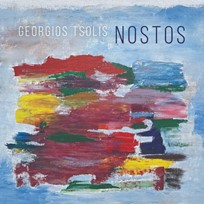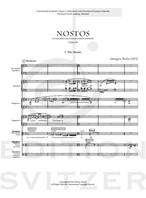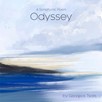
Nostos
Composer: Georgios Tsolis
Instrument: Percussion Ensemble
Level: Advanced
Published: 2022
Price: €70.00
Item details
-
Description +
-
Preface
Nostos is the Greek word for “Homecoming” the word that describes the return to homeland after a long travel, This return hides no expectations only the desire for the return to the roots for settling a deeper connection with the ground of one’s existence, the memories from childhood the first words spoken the first love the first experiences of life the beginning of light in one’s life.
The latest work (op. 10) of Composer Georgios Tsolis, created for solo marimba and percussion ensemble describes the joy of the long travel the experiences gained and the desire of homecoming the longing for each ones “Ithaca” as a symbol of return. It consists of 3 parts where Tsolis attempts to describe different destinations and interaction with different cultures, persons and “colors” of life.
Part I “The Dream”: It all begins when the curiosity of one creates the longing for traveling for going away and explore. In this part the palette of colours the different harmonic an melodic material attempt to describe the diversity of such a travel, different thematically ideas where they succeed one another are coexisting in this piece of music, organically connected with each other they represent the long travel full of experiences the different ports that ones “ship” stops to.
Part II “Nostalgia”: (Greek: Νοσταλγία) it is a synthetic word “Nostos” (gr. νόστος) & “Algos” (gr. άλγος), in translation: “Homecoming” & “pain”, it means the desire of homecoming the pain that the absence of homeland creates to one, the need to connect with ones roots and discover its own existence. This type of “Pain” it is described by a designed sound scape of extended techniques where the melancholic melody of Marimba can lay on, in this part the internal personal fight the fire of feelings thoughts and desires gives their way to the decision of return and the final resolution of this in a Tonal center.
Part III “Ithaca”: (gr. Ιθάκη) the homeric island of the legendary king Ulysses (gr. οδυσσεας) which he conquered Troy. His human weakness leads him to arrogance that insults the gods and especially God Poseidon. Ulysses lost his faith to the gods, who condemned him to a long and difficult travel back home.
Ithaca it is a real place an island in the complex of the Ionian Islands West Greece witch it is also the mother land of the composer itself it is the place that he lived a big part of his childhood. This place that for many became the symbol of “destination” the symbol of the achievement and goals is also his own destination and life philosophy.
Everyone has its own Ithaca to keep in mind while traveling, for every person Ithaca is the destination “without Ithaca you would never settle for the beautiful travel” as poet kavafi mentions in his homonymous poem “Ithaca”.
A happy joyful melody with lots of elements taken from Jazz music marks the happy return at home the goal witch it is a part of life, the destination the “homecoming”. The rhythmical odd meters patterns the tutti lines and the dynamic end marks the convergence of Events and decisions that lead to a way…. The one “Back Home “ back to “Ithaca”.
Nostos was premiered by Theodor Milkov with Percurama Percussion Ensemble at The Royal Danish Academy, Denmark on 5 April 2022.
-
-
Instrumentation +
-
Player 1
Marimba (5.Octave)
Player 2
Marimba (5.Octave)
Player 3
Vibraphone
Glockenspiel
Player 4
Vibraphone
Player 5 (percussion I)
3 Susp. Cymbals (16”, 18”, 21”)
1 China Cymbal (12”)
Crotales (1.Octave)
1 Timpani (32”), if available
Player 6 (percussion II)
Tambourine
2 Bongos
Snare Drum
Player 7 (percussion III)
Snare Drum (piccolo)
3 Tom-Toms (low-medium-high)
Bass Drum (28-32”)
-
-
About the composer +
-
Born and raised in Kefalonia, Ionian Islands, Greek pianist and composer Georgios Tsolis currently resides in the Hague, the Netherlands since 2004. Studied at the Royal Conservatory of the Hague where he gained his bachelor and masters in jazz piano performance. Emerging from the jazz scene as an established musician, he has been active for the last 15 years with appearances in various festivals and locations around Europe, receiving excellent reviews for his work both as a composer and performer.
Composition has always been the key element and life companion in his musical journey. “Daring to diverge” is an expression of creativity for him. A constant quest for oneself as the key to continuous progress and development is a view of life and music is his vehicle to this quest. He composed music for solo piano, jazz trios, quartets, big band and orchestra. Lately he is debuting as a composer into the world of contemporary classical music with a series of sonatas for solo marimba and many more to come.
As a composer, he has the tendency to experiment with the expansion of the harmonic and melodic language within traditional forms. His musical influences from jazz and improvisation, to Greek traditional music and classical, is incorporate into his music; a coexistence and guide on the way to the development of his own sound and language.
-
-
Reviews +
-
Review (Percussive Notes, February 2025)
Georgios Tsolis gives us a multi-movement tone poem, taking both performer and listener on a journey. This piece will challenge everyone. Beyond the solo part, the other mallet parts are quite challenging, and the three percussion parts present a good amount of rhythmic difficulty.This piece starts with perhaps its most challenging movement, The Dream. I appreciate the disparity in the parts; each performer has unique music. While there are occasional unisons, Tsolis does not write too many, which makes the rhythmic unisons in the third movement more impactful.
Nostalgia is exceptional. This is accomplished through its harmonic language and its striking textures. The vibraphones are bowed throughout, the second marimba part only uses tremolos, and the battery percussion is sparse. Listed at quarter note = 40, it is very challenging to find a clear pulse, considering the articulation of those textures. This way of writing gives the marimba soloist ample freedom in phrasing.
A note for this movement: it is mentioned in the performance notes that a 32-inch timpano is needed (if available), used for a China cymbal to be rolled above, but later in the movement, it asks for a long E3 roll. Due to this pitch, I would add a 26- or 23-inch timpani to the instrumentation.
Ithaca begins with a 7/8 groove in the second marimba part. This sets up the whole movement, as it moves through many odd meters seamlessly. This movement never loses momentum as it advances toward a triumphant ending. Its “happy and joyful melody,” along with the unisons, gives an apt resolution to movements one and two.
Nostos is a great showcase for the entire ensemble. Listed as “advanced,” I like to use the word “mature” as well. An ensemble could have the talent to learn all the notes and rhythms, but it may take more than that to realize Tsolis’ vision. With that said, this piece would be great for a strong college or professional percussion group.
—Stephen Busath
-
-
Credits +
-
Painting: Andrew Rafalski
Photo: YIannis Lostopoulos
Printed in Copenhagen, Denmark
Copyright © Edition SVITZER
www.editionsvitzer.com
With support from Koda’s Cultural Funds
-




